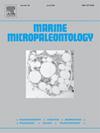突尼斯海陆盆地中新世鞭毛藻囊的分布:古地理古生态重建与涨落运动
IF 1.5
4区 地球科学
Q2 PALEONTOLOGY
引用次数: 0
摘要
突尼斯东北部和中东部中新世沉积主要为碎屑三角洲型。这些矿床被构造活动、地壳起伏和气候条件的变化组织成复杂的沉积序列。本研究介绍了中新世沉积物中提取的鞭毛藻囊群的演化。这些沉积物分布在1600万到530万年前。这些数据取自突尼斯东北部和中部的三个钻孔和三个区域。恐龙囊是气候变化和海平面波动的重要指标。他们的研究支持了从花粉粒分析中得到的结果。它揭示了这一时期的古生态、古地理和涨落情况。根据这些海洋微生物的生态偏好,建立了各种关联(海洋、浅海、气候等)。海洋环境的特点是含银的存在。浅海环境是由Cordosphaeridium inodes minimus的存在所定义的。同时,线虫和复盖虫对海洋环境具有浅海性。Lejeunecysta、opercullodinium、israelium、Polysphardium zoharyi、Homotryblium、Spiniferites、Cleistosphaeridium和Lingulodinium machaerophorum的丰度证实了这一点。这些结果与古水深测量和古地理相关的岩性和生物地层资料一致。恐龙囊分类群相对丰度的变化有助于追踪中新世期间海岸线的演变。Impagidinium和Cordosphaeridium inodes minimum相对丰度的变化或缺乏表明环境的变化。这种转变反映了从浅海环境(Aïn Grab组)到海洋环境(Mahmoud组)的转变。Saouaf组的特征是其底部(Unit I)的起伏下降。然而,Unit II和Unit III是由脉动的起伏上升所定义的。Somaa砂沉积在浅海和/或陆表环境中,随后返回到海洋环境(Melquart组)。本文章由计算机程序翻译,如有差异,请以英文原文为准。
Distribution of Miocene dinoflagellate cysts in the paralic basins of Tunisia: Paleogeographic and paleoecological reconstruction and eustatic movements
The Miocene deposits of northeastern and central-eastern Tunisia are primarily of clastic, deltaic-type. These deposits are organized into complex sedimentary sequences shaped by tectonic activity, eustatic fluctuations, and changes in climatic conditions. This study presents the evolution of dinoflagellate cysts associations extracted from Miocene-age deposits. These deposits ranged from 16 million to 5.3 million years ago. They are taken from three boreholes and three sections in northeastern and central Tunisia. Dinocysts serve as valuable indicators of climatic variations and sea-level fluctuations. Their study supports the results obtained from the analysis of pollen grains. It sheds light on paleoecology, paleogeography, and eustatic conditions during that period.
Various associations (oceanic, neritic, climatic, etc.) were established based on the ecological preferences of these marine microorganisms. Oceanic conditions are characterized by the presence of Impagidinium. Shallow marine environments are defined by the presence of Cordosphaeridium inodes minimus. Meanwhile, Nematosphaeropis and Tectatodinium indicate a neritic to oceanic environment. It is confirmed by the abundance of Lejeunecysta, Operculodinium, israelianum, Polysphardium zoharyi, Homotryblium, Spiniferites, Cleistosphaeridium, and Lingulodinium machaerophorum. These results align with lithological and biostratigraphic data related to paleobathymetry and paleogeography.
Changes in dinocyst taxa relative abundances helped track the shoreline's evolution during the Miocene. Variations in the relative abundance of Impagidinium and Cordosphaeridium inodes minimus, or their absence, indicate environmental shifts. This shift reflects a transition from a neritic environment (Aïn Grab Formation) to an oceanic one (Mahmoud Formation). The Saouaf Formation is marked by a eustatic drop at its base (Unit I). However, Units II and III are defined by eustatic rises in pulsations. The Somaa sands were deposited in a neritic and/or epicontinental environment, followed by a return to an oceanic setting (Melquart Formation).
求助全文
通过发布文献求助,成功后即可免费获取论文全文。
去求助
来源期刊

Marine Micropaleontology
地学-古生物学
CiteScore
3.70
自引率
15.80%
发文量
62
审稿时长
26.7 weeks
期刊介绍:
Marine Micropaleontology is an international journal publishing original, innovative and significant scientific papers in all fields related to marine microfossils, including ecology and paleoecology, biology and paleobiology, paleoceanography and paleoclimatology, environmental monitoring, taphonomy, evolution and molecular phylogeny. The journal strongly encourages the publication of articles in which marine microfossils and/or their chemical composition are used to solve fundamental geological, environmental and biological problems. However, it does not publish purely stratigraphic or taxonomic papers. In Marine Micropaleontology, a special section is dedicated to short papers on new methods and protocols using marine microfossils. We solicit special issues on hot topics in marine micropaleontology and review articles on timely subjects.
 求助内容:
求助内容: 应助结果提醒方式:
应助结果提醒方式:


